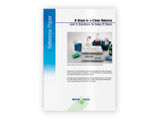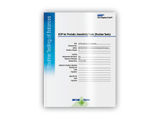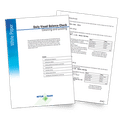To use all functions of this page, please activate cookies in your browser.
my.chemeurope.com
With an accout for my.chemeurope.com you can always see everything at a glance – and you can configure your own website and individual newsletter.
- My watch list
- My saved searches
- My saved topics
- My newsletter
Amphotericin B
Amphotericin B (Fungilin, Fungizone, Abelcet, AmBisome, Fungisome, Amphocil, Amphotec) is a polyene antifungal drug, often used intravenously for systemic fungal infections. It was originally extracted from Streptomyces nodosus, a filamentous bacterium, in 1955 at the Squibb Institute for Medical Research from cultures of an undescribed streptomycete isolated from the soil collected in the Orinoco River region of Venezuela. Its name originates from the chemical's amphoteric properties. Two amphotericins, Amphotericin A and Amphotericin B are known, but only B is used clinically because it is significantly more active in vivo. Currently the drug is available as plain Amphotericin B, as cholesteryl sulfate complex, as lipid complex, and as liposomal formulation. The latter formulations have been developed to improve tolerability for the patient but may show considerably different pharmacokinetic characteristics compared to plain Amphotericin B. Additional recommended knowledge
UsesOral preparations of amphotericin B are used to treat oral thrush; these are virtually nontoxic. The main i.v. use is in systemic fungal infections (e.g. in immunocompromised patients), and in visceral leishmaniasis. Aspergillosis, Naegleria fowleri primary amoebic meningoencephalitis, cryptococcus infections (e.g. meningitis) and candidiasis are treated with amphotericin B. It is also used empirically in febrile immunocompromised patients who do not respond to broad-spectrum antibiotics. Mechanism of actionAs with other polyene antifungals, amphotericin B associates with ergosterol, a membrane chemical of fungi, forming a pore that leads to K+ leakage and fungal cell death. Recently, however, researchers found evidence that pore formation is not necessarily linked to cell death (i.e. Angewandte Chemie Int. Ed. Engl. 2004). The actual mechanism of action may be more complex and multi-faceted. Amphotericin B is believed to interact with membrane sterols (ergosterol) to produce an aggregate that forms a transmembrane channel. Intermolecular hydrogen bonding interactions among hydroxyl, carboxyl and amino groups stabilize the channel in its open form, destroying activity and allowing the cytoplasmic contents to leak out. Side effectsVery often a serious acute reaction after the infusion (1 to 3 hours later) is noted consisting of fever, shaking chills, hypotension, anorexia, nausea, vomiting, headache, dyspnea, and tachypnea. This reaction sometimes subsides with later applications of the drug and may in part be due to histamine liberation. An increase in prostaglandin-synthesis may also play a role. Often the most difficult decision has to be made, whether the fever is disease- or drug-related. In order to decrease the likelihood and severity of the symptoms, initial doses should be low and increased slowly. The liposomal preparation obviously has a lower incidence of the syndrome. Acetaminophen, pethidine, diphenhydramine and/or hydrocortisone have all been used to treat or prevent the syndrome, but the prophylactic use of these drugs should be limited. Nephrotoxicity (kidney damage) is a major issue and can be severe and/or irreversible. It is much milder when amphotericin B is delivered in liposomes (AmBisome). Electrolyte imbalances (e.g. hypokalemia and hypocalcemia) may also occur. Increased liver enzymes and hepatotoxicity up to acute liver failure, several forms of anemia and other blood dyscrasias (leukopenia, thrombopenia), serious cardiac arrhythmias (including ventricular fibrillation), and cardiac failure have also been reported frequently. Skin reactions, including serious forms, are also possible. Interactions
Liposomal and lipid complex preparationsFrom studies it appears that liposomal amphotericin B preparations exhibit fewer side-effects while having similar efficacy. Various preparations have recently been introduced. All of these are more expensive than plain Amphotericin B. AmBisome is a liposomal formulation of amphotericin B for injection, developed by NeXstar Pharmaceuticals (acquired by Gilead Sciences in 1999). It is marketed by Gilead in Europe and licensed to Astellas Pharma (formerly Fujisawa Pharmaceuticals) for marketing in the USA, and Sumitomo Pharmaceuticals in Japan. Fungisome is a liposomal complex of Amphotericin B and being the latest and cheapest addition to the lipid formulations of Amphotericin B has many advantages. It is marketed by Lifecare Innovations of India. Other formulations include Amphotec (Intermune) and Abelcet (Enzon Pharmaceuticals). Abelcet is not a liposomal preparation but rather a lipid complex preparation.
Categories: Gilead Sciences | Antifungals | Polyketide antibiotics |
|||||||||||||||||||||||||||||||||||||||||||||||||||||||||||||||||||||||||||||||||||||||||||||||||
| This article is licensed under the GNU Free Documentation License. It uses material from the Wikipedia article "Amphotericin_B". A list of authors is available in Wikipedia. | |||||||||||||||||||||||||||||||||||||||||||||||||||||||||||||||||||||||||||||||||||||||||||||||||







